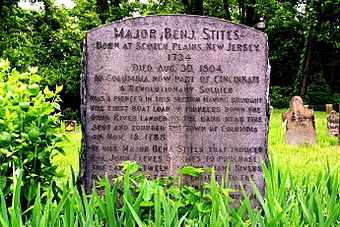Pioneer Memorial Cemetery, Cincinnati facts for kids
Quick facts for kids |
|
|
Columbia Baptist Cemetery
|
|

Gravestone of Major Benjamin Stites.
|
|
| Location | Cincinnati, Ohio |
|---|---|
| Built | 1790 |
| MPS | Columbia-Tusculum MRA |
| NRHP reference No. | 79002709 |
| Added to NRHP | August 24, 1979 |
The Pioneer Memorial Cemetery is a very old and important cemetery in Cincinnati, Ohio. It is also known as the Columbia Baptist Church Cemetery. You can find it on a small hill in the Columbia-Tusculum neighborhood, looking over Lunken Airport. This historic spot is located at 333 Wilmer Avenue on Cincinnati's east side.
Contents
A Glimpse into History
This cemetery is the oldest one in Hamilton County. It was started in 1790, right where the Columbia Baptist Church once stood. The area called Columbia was actually the first settlement in Hamilton County. It was founded in 1788, which was one month before Losantiville. Losantiville later grew into the city of Cincinnati. Today, the Pioneer Memorial Cemetery is the only part of the original Columbia settlement that still remains.
Important People Buried Here
Many early pioneers are buried or honored at this cemetery. One of the most important graves belongs to Major Benjamin Stites. He lived from 1734 to 1804 and was a founding father of the Columbia settlement. Another key figure, Ephraim Kibbey, is also remembered here. Kibbey (1756-1809) was a pioneer, a soldier, and a lawmaker. A special monument was built in 1879 to honor him and the "First Boat-load" of settlers.
Caring for the Cemetery
In 1967, a project began to restore the cemetery. Frederick L. Payne, who was a Supervising Horticulturalist for the Park Board at the time, led this effort. The cemetery is officially recognized as a historic place. It was added to the National Register of Historic Places on August 24, 1979. It is listed under its historic name, "Columbia Baptist Cemetery."
Discovering an Ancient Village
The Pioneer Memorial Cemetery is not just a burial ground; it's also an archaeological site. In 1958, scientists found proof that the land where the cemetery sits was once a Native American village. This village existed during the Woodland period, which was a long time ago.
Because the cemetery is there, no digging has ever been done at the site. This means that everything we know about the ancient village comes from surface findings. We know it was inhabited during the Woodland period, but we don't have many other details. The Cincinnati Parks Department takes care of the property today, making sure this important historical and archaeological site is preserved.



